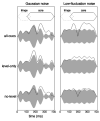Development and the role of internal noise in detection and discrimination thresholds with narrow band stimuli
- PMID: 17139738
- PMCID: PMC1851678
- DOI: 10.1121/1.2354024
Development and the role of internal noise in detection and discrimination thresholds with narrow band stimuli
Abstract
The experiments reported here examine the role of internal noise in the detection of a tone in narrow band noise and intensity discrimination for narrow band stimuli in school-aged children as compared to adults. Experiment 1 used 20-Hz wide bands of Gaussian and low-fluctuation noise centered at 500 Hz to assess the role of stimulus fluctuation in detection of a 500-Hz pure tone. Additional conditions tested whether performance was based on level and/or level-independent cues. Children's thresholds were elevated with respect to adults, and whereas adults benefited from the reduced fluctuation of low-fluctuation noise, children did not. Results from both groups were consistent with the use of a level cue. Experiment 2 estimated intensity increment thresholds for a narrow band Gaussian noise or a pure tone, either with or without a presentation-by-presentation level rove, an additional source of level variability. Stimulus variability was found to have a larger effect on performance of adults as compared to children, a rather counterintuitive finding if one thinks of children as more prone to informational masking introduced by stimulus variability. Both tone-in-noise and intensity discrimination data were consistent with the hypothesis that children's performance is limited by greater levels of internal noise.
Figures




Similar articles
-
Effect of signal-temporal uncertainty in children and adults: tone detection in noise or a random-frequency masker.J Acoust Soc Am. 2013 Dec;134(6):4446. doi: 10.1121/1.4828828. J Acoust Soc Am. 2013. PMID: 25669256 Free PMC article.
-
Effects of masker envelope coherence on intensity discrimination.J Acoust Soc Am. 2009 Nov;126(5):2467-78. doi: 10.1121/1.3212944. J Acoust Soc Am. 2009. PMID: 19894827 Free PMC article.
-
Gap detection in school-age children and adults: effects of inherent envelope modulation and the availability of cues across frequency.J Speech Lang Hear Res. 2014 Jun 1;57(3):1098-107. doi: 10.1044/2014_JSLHR-H-13-0132. J Speech Lang Hear Res. 2014. PMID: 24686553 Free PMC article.
-
The effect of narrow-band noise maskers on increment detection.J Acoust Soc Am. 2010 Nov;128(5):2973-87. doi: 10.1121/1.3488671. J Acoust Soc Am. 2010. PMID: 21110593 Free PMC article.
-
High-level psychophysical tuning curves: simultaneous masking by pure tones and 100-Hz-wide noise bands.J Speech Hear Res. 1991 Apr;34(2):360-73. J Speech Hear Res. 1991. PMID: 2046360
Cited by
-
Aperiodic EEG Predicts Variability of Visual Temporal Processing.J Neurosci. 2024 Oct 2;44(40):e2308232024. doi: 10.1523/JNEUROSCI.2308-23.2024. J Neurosci. 2024. PMID: 39168653 Free PMC article.
-
Factors affecting the processing of intensity in school-aged children.J Speech Lang Hear Res. 2013 Feb;56(1):71-80. doi: 10.1044/1092-4388(2012/12-0008). Epub 2012 Aug 15. J Speech Lang Hear Res. 2013. PMID: 22896044 Free PMC article.
-
Effects of Masker Envelope Fluctuations on the Temporal Effect.J Assoc Res Otolaryngol. 2018 Dec;19(6):717-727. doi: 10.1007/s10162-018-00688-x. Epub 2018 Aug 20. J Assoc Res Otolaryngol. 2018. PMID: 30128623 Free PMC article.
-
Use of auditory learning to manage listening problems in children.Philos Trans R Soc Lond B Biol Sci. 2009 Feb 12;364(1515):409-20. doi: 10.1098/rstb.2008.0187. Philos Trans R Soc Lond B Biol Sci. 2009. PMID: 18986969 Free PMC article. Review.
-
Spectral Resolution Development in Children With Normal Hearing and With Cochlear Implants: A Review of Behavioral Studies.J Speech Lang Hear Res. 2022 Apr 4;65(4):1646-1658. doi: 10.1044/2021_JSLHR-21-00307. Epub 2022 Feb 24. J Speech Lang Hear Res. 2022. PMID: 35201848 Free PMC article. Review.
References
-
- Allen P, Jones R, Slaney P. The role of level, spectral, and temporal cues in children’s detection of masked signals. J Acoust Soc Am. 1998;104:2997–3005. - PubMed
-
- Allen P, Nelles J. Development of auditory information integration abilities. J Acoust Soc Am. 1996;100:1043–1051. - PubMed
-
- Allen P, Wightman F. Psychometric functions for children’s detection of tones in noise. J Speech Hear Res. 1994;37:205–215. - PubMed
-
- Allen P, Wightman F. Effects of signal and masker uncertainty on children’s detection. J Speech Hear Res. 1995;38:503–511. - PubMed
-
- ANSI. Specification for Audiometers. American National Standards Institute; New York: 1996. S3-1996.
Publication types
MeSH terms
Grants and funding
LinkOut - more resources
Full Text Sources
Medical

